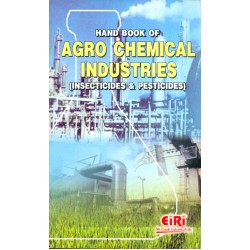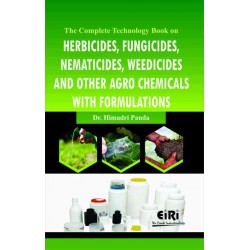Manufacture of Pesticides and Insecticides with Processes and Formulations

- More than 45 years of experience
- Managed by expert industrial consultants
- ISO 9001-2015 Certified
- Registered under MSME, UAM No: DL01E0012000
- 24/5 Research Support
Get your quesries resolved from an industry expert. Ask your queries before report or book purchase. - Custom Research Service
Speak to the our consultant to design an exclusive study to serve your research needs. - Quality Assurance
All reports are prepared by highly qualified consultants & verified by a panel of experts. - Information Security
Your personal & confidential information is safe & secure.
- Pesticide Formulations
- Introduction
- Liquid Formulations
- Emulsifiable Concentrates (EC or E)
- Ready-to-Use Low Concentration Solutions (RTU)
- Ultra-Low Volume (ULV)
- Invert Emulsions
- Flowables (F)/Liquids (L)
- Aerosols (A)
- Ready-to-use aerosol insecticide.
- Liquid Baits
- Dry or Solid Formulations
- Dusts (D)
- Baits (B)
- Granules (G)
- Pellets (P or PS)
- Fumigant formulated as tablets (pellets)
- Wettable Powders (WP or W)
- Soluble Powders (SP or WSP)
- Other Formulations
- Microencapsulated Materials (M or ME)
- Water-Soluble Packets (WSB or WSP)
- Attractants
- Impregnated Products
- Repellents
- Animal Systemics
- Pesticide/Fertilizer Combinations
- Fumigants
- Advantages of fumigants
- Disadvantages of fumigants
- Adjuvants
- Definition of pesticide
- Historical background of pesticides use in agriculture and public health
- Impacts of pesticides use in agriculture and public health
- Side effects of pesticides use to the environment and public health
- How can pesticides be identified?
- How are the common names of pesticides derived?
- Classification of pesticides
- Classification of pesticides based on the mode of action
- Classification of pesticides based on the
- targeted pest species
- Classification of pesticides based on the chemical composition
- Other minor classes of pesticides
- Activity spectrum of the pesticide
- Mode of formulation
- Toxicity level
- General physical properties of pesticides
- Molecular weight and form
- Vapour pressure (VP)
- Solubility
- Octanol/Water partition coefficien- Kow (Log Kow)
- Soil adsorption coefficient Koc/Kd
- Henry`s law constant-H`
- Specific physical properties of selected representative pesticides
- Oxidation reaction of pesticides
- Reduction reaction of pesticides
- Hydrolysis reaction of pesticides
- Photodegradation of pesticides
- Biodegradation
- The Process
- The Problem
- The Solution
- Silverson Flashblend
- High Shear In-Line Mixers
- The Advantages
- Introduction
- Pesticide Use
- Acephate
- Aluminium Phosphide
- Captan
- Metaphenoxy benzaldehyde (MPBAD)
- Malathion Preparation
- Methyl Bromide
- Emissions Profile in Pesticide Industries
- Solvents
- Introduction
- History of pesticide use
- Trends in pesticide use
- Regulation on pesticides
- Pesticide formulations
- Types of formulations
- Pesticides, non-target organisms and our
- environment
- Improvisation in pesticide use
- Monitoring for pesticide residues
- Future challenges
- Description
- Examples
- Prior Art
- Final Composition of the Biopesticides
- Shelf Life
- Feeding Substrate Evaluations
- Laboratory Evaluation of an Embodiment
- of the Biopesticide
- Preliminary Field Evaluation of Biopesticide
- Overwintered Adults in Early Season Cotton
- Non-Cotton Habitat Test
- Regrowth Cotton Test
- Bait Stations
- Experimental Field Trials
- Bioassays of Beauveria Bassiana, Deposit
- ATCC- (ASREF-)
- Organophosphate Insecticides
- Toxicology
- Signs and Symptoms of Poisoning
- Confirmation of Poisoning
- Organophosphates
- Ethoprop
- Fenamiphos
- Cadusafos
- Fosthiazate
- Other Organophosphates
- Biochemicals
- DiTera
- ClandoSan
- Sincocin
- Fumigants
- Nonfumigants
- Mammalian Anthelmintics
- Fumigation
- Irrigation
- Granules and Broadcast Sprays
- Seed Dressing and Bare Root Dip
- Effects of Temperature on Activity
- Effects of Soil Structure on Activity
- Degradation of Nematicides
- Effects on Nontarget Organisms
- Methyl Iodide and Propargyl Bromide
- DMDP
- Avermectins
- Sodium Azide
- Furfural
- Phytochemicals
- Systemic Acquired Resistance Inducers
- Hatching Stimulants and Inhibitors
- Transgenic Proteins
- Behavior-Modifying Compounds
- Steroids and Hormones
- Introduction
- Plant material
- Extraction
- Quality detection
- Biological effect test
- Biological activity
- Study area
- Preparation of the insecticide
- Statistical analysis
- Results for Application of the Prepared Insecticide
- Introduction
- Chemical identifying information for Carbaryl
- Routes of Sevin synthesis
- Introduction
- Materials and Methods
- Materials
- Methods
- General Reaction Procedure
- Instrumental Analysis
- Bench Reactor Set-Up and Batch Scale
- Results and Discussion
- Introduction
- Experimental Section
- Reagents and Instruments
- Baxter Instrument Co, Ltd)
- Preparation method of chlorpyrifos microcapsules
- Determination of optimal experimental conditions
- Optimization method of raw materials ratio
- The methods of characterization
- Drawing of standard curve
- Measurement of encapsulation efficiency
- Testing methods of stability
- Storage experiment in high temperature
- Storage experiment in low temperature
- Determination of the optimal ratio of raw materials
- Determination of dispersant amount
- The results of storage in low temperature
- DDT
- The Most Famous (and Infamous) Insecticide
- The Malaria-buster
- Insecticides
- Prior or Present Art
- Synthesis of Triazophos
How to Make Project Report?
Detailed Project Report (DPR) includes Present Market Position and Expected Future Demand, Technology, Manufacturing Process, Investment Opportunity, Plant Economics and Project Financials. comprehensive analysis from industry covering detailed reporting and evaluates the position of the industry by providing insights to the SWOT analysis of the industry.
Each report include Plant Capacity, requirement of Land & Building, Plant & Machinery, Flow Sheet Diagram, Raw Materials detail with suppliers list, Total Capital Investment along with detailed calculation on Rate of Return, Break-Even Analysis and Profitability Analysis. The report also provides a birds eye view of the global industry with details on projected market size and then progresses to evaluate the industry in detail.
We can prepare detailed project report on any industry as per your requirement.
We can also modify the project capacity and project cost as per your requirement. If you are planning to start a business, contact us today.
Detailed Project Report (DPR) gives you access to decisive data such as:
- Market growth drivers
- Factors limiting market growth
- Current market trends
- Market structure
- Key highlights
Overview of key market forces propelling and restraining market growth:
- Up-to-date analyses of market trends and technological improvements
- Pin-point analyses of market competition dynamics to offer you a competitive edge major competitors
- An array of graphics, BEP analysis of major industry segments
- Detailed analyses of industry trends
- A well-defined technological growth with an impact-analysis
- A clear understanding of the competitive landscape and key product segments
Need Customized Project Report?
- Ask for FREE project related details with our consultant/industry expert.
- Share your specific research requirements for customized project report.
- Request for due diligence and consumer centric studies.
- Still haven't found what you're looking for? Speak to our Custom Research Team
About Engineers India Research Institute:
Note: We can also prepare project report on any subject based on your requirement and country. If you need, we can modify the project capacity and project cost based on your requirement.
Our Clients

Our Approach
- Our research reports comprehensively cover Indian markets (can be modified as per your country), present investigation, standpoint and gauge for a time of five years*.
- The market conjectures are produced on the premise of optional research and are cross-accepted through associations with the business players
- We use dependable wellsprings of data and databases. What's more, data from such sources is handled by us and incorporated into the report
Why buy EIRI reports?
- Our project reports include detailed analysis that help to get industry Present Market Position and Expected Future Demand.
- Offer real analysis driving variables for the business and most recent business sector patterns in the business
- This report comprehends the present status of the business by clarifying a complete SWOT examination and investigation of the interest supply circumstance
- Report gives investigation and top to bottom money related correlation of real players/competitors
- The report gives gauges of key parameters which foresees the business execution
























